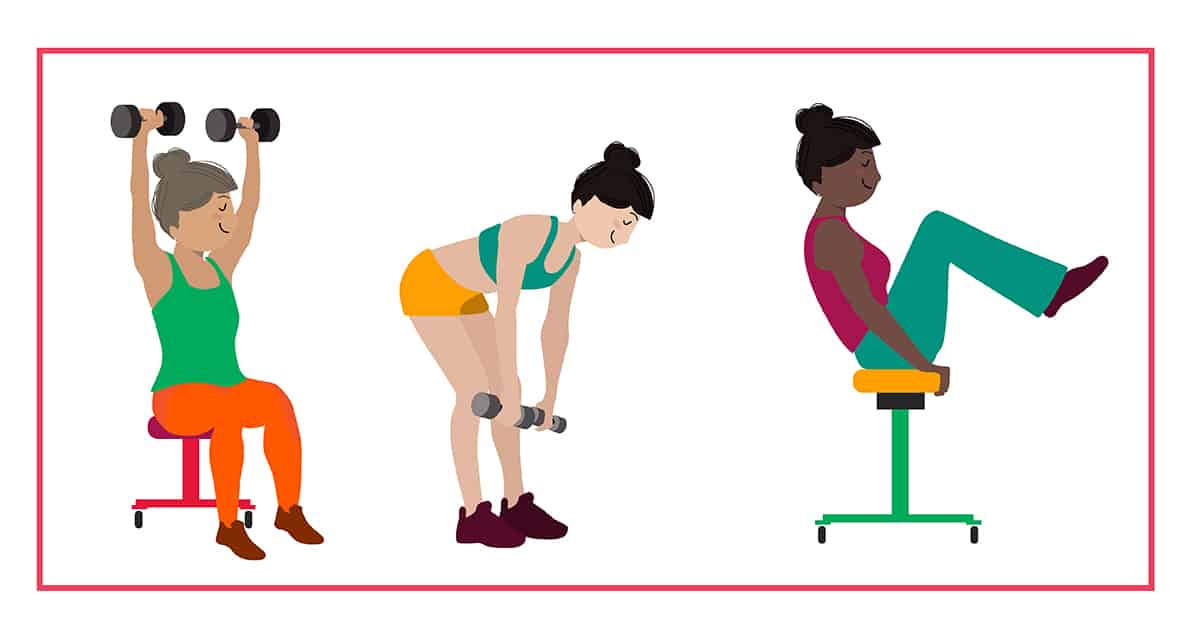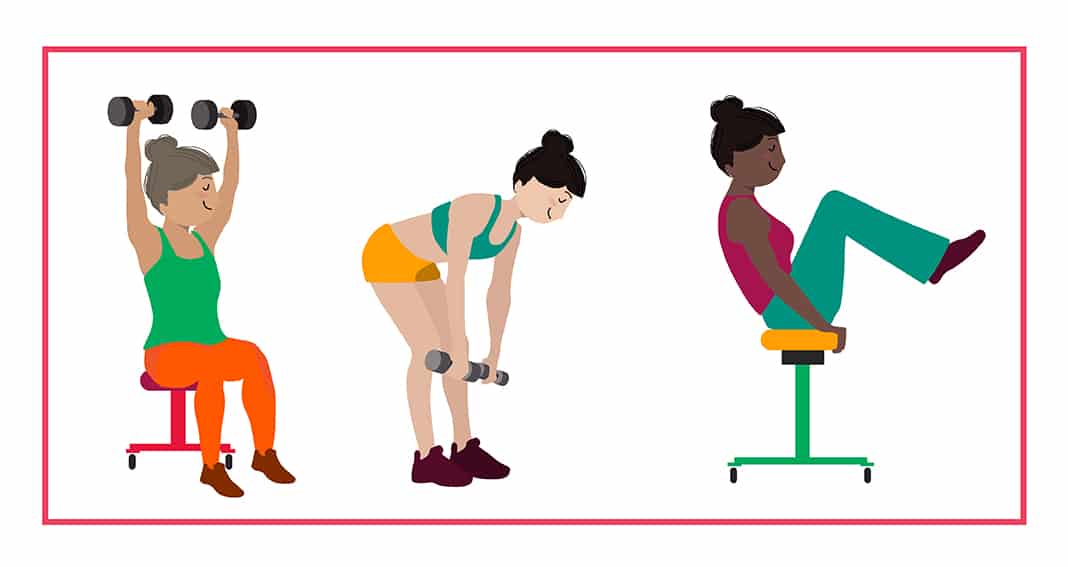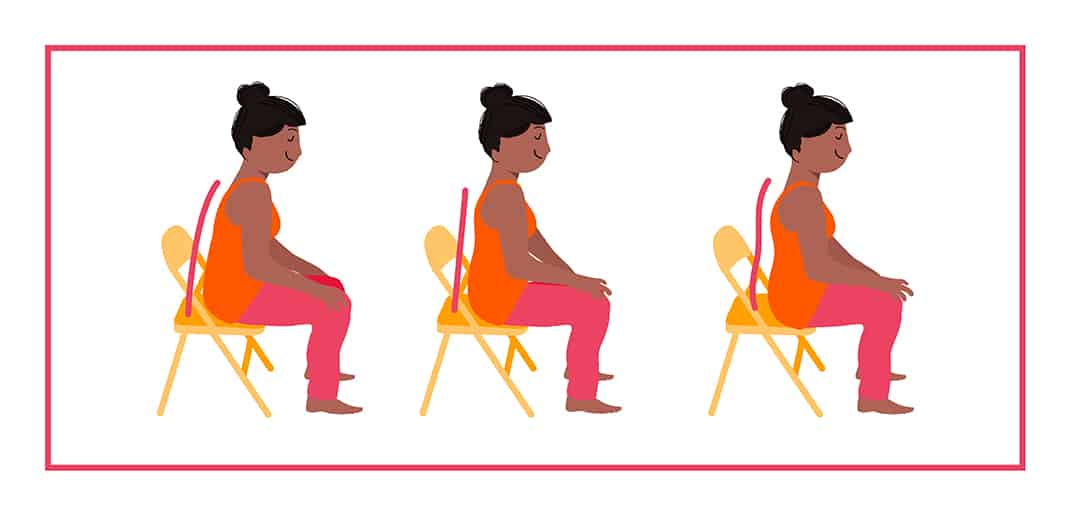Open any popular fitness magazine and you’ll see tons of seated exercises for the back, biceps, and shoulders. But do seated resistance training exercises reign supreme? Or is it better to stand during weight training session?
Here we break down the risks and rewards of both seated and standing exercises, which exercises are best suited for each position, and how to lift safely—whether you stand or sit.
The Posture Analysis
Sitting allows us to feel more stable: Our center of gravity is closer to the ground. However, when seated versus standing, a look at the spine shows how difficult it is to maintain proper posture.
The spine has a natural lumbar (lower spine) curve in both standing and seated positions. However, most of us lose that natural curve when we sit as the pelvis tilts forward and the lower back rounds. This can be associated with a stress response, since the modern workforce is comprised mostly of chairs. Sitting for long hours at the office puts us on defense as we hunch over in restrictive positions as a response to work stress, which can transfer to poor seated posture in the gym.
Before you decide whether to sit or stand (or do both) during your workout, check your posture to make sure you are not loading the spine in a compromised position.
During the workday, most office workers sit with a posterior pelvic tilt. This position has the pelvis positioned forward, which causes the lower spine to round, resulting in an unstable spinal position. Often during exercise, we’re tempted to reverse the position into an anterior pelvic tilt, meaning the buttocks sit well behind the spine. This also creates spinal instability. Both tilts can result in low back pain and discomfort.
The optimal seated position during exercise is a neutral spine in a braced position. According to Dr. Kelly Starrett, author of Supple Leopard, neutral bracing has little to do with muscle strength (like hitting a one-rep max in a lift) and more to do with muscle endurance (in this case the ability for your abdominal muscles to brace for an extended period of time). Losing this bracing is often what leads to back pain at the end of a workout. The more you load the spine, the harder your core has to work to maintain a good spinal position. So, it’s not just about moving more weight, but moving weight effectively while maintaining a braced position.
How to Get Your Posture in Line
We’ve determined that the spine is in a compromised position while seated, so before you load up with weights it’s important to check your posture. Working on bracing with a neutral spine from a seated position can begin in everyday life. Practice this while at the office, eating dinner, or watching your favorite TV show.
Establishing healthy sitting patterns throughout your day will not only decrease the risk of back pain and improve overall health, but also prepare you for the gym.
The Bracing Sequence
The bracing sequence develops good posture habits and can be practiced daily while seated at work, in the car, or at the dinner table. The method transfers well to seated exercises, so the more you practice at home and work, the better prepared you will be for seated exercise in the gym.
- Contract your glutes as hard as you can while in a seated position.
- Anchor your ribs down so they align with your hipbones. Do not let them flair out.
- Inhale with a deep belly breath, and then as you exhale tighten the core with a good 20 percent tension. Don’t use 100 percent of your effort so that you end up in a seated crunch.
- Tuck your chin slightly so the head is in neutral position.
- Pull your shoulder blades down, away from the ears.
Sitting vs. Standing
Once you have your posture down pat, it’s time to determine whether to sit or stand during your workouts. Sitting has some advantages for beginners who are new to resistance training, or have balance or stability issues when standing. Exercising while sitting can help you pack a few more pounds on to your lifts, due to the decreased distance force has to travel when you exert yourself. When you sit, your pelvis is the point of contact with surface, so you produce more force in a shorter distance than if your feet were the point of contact.
However, research shows standing during exercise increases stability and helps improve neuromuscular adaptations, leading to overall better performance. According to a Norwegian study that compared sitting to standing overhead press variations, the standing versions came out on top when comparing stability and muscle activation. Researchers concluded that the overhead press required more stability when standing, demonstrating greater neuromuscular activity in the deltoid muscles. The study also showed greater muscle activation in the biceps and triceps when standing. The only caveat in this study was the decreased one-rep max that occurred with standing versus seated, putting the seated position at a slight advantage when it comes to increasing strength. Though this study only analyzes one exercise, these principles can be applied to many other exercises.
Final Thoughts
Whether you sit or stand, it’s important to work on proper posture so your spine stays in a safe, protected position during all exercises.




One reply on “Sit or Stand: Which Is Better in the Weight Room?”
Where is my free shipping coupon for a $149.00 purchase?. I did not received it after my subscription. .